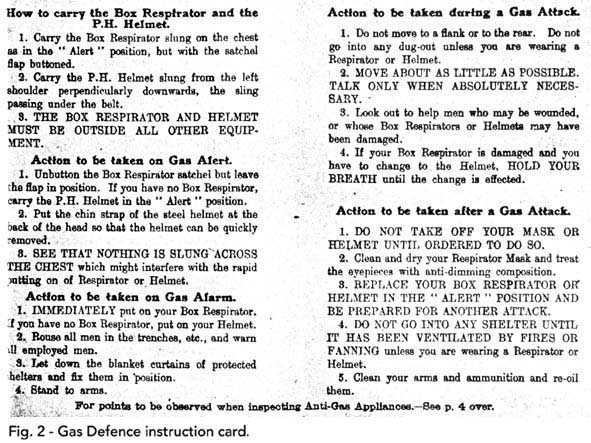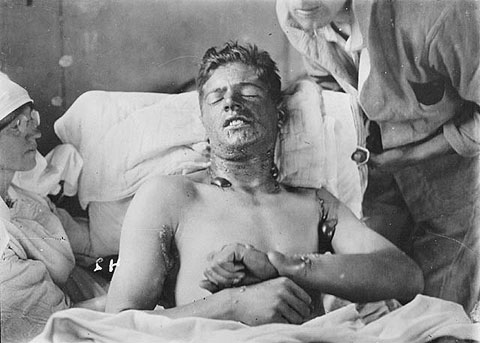|
This is a Diagrammatical Plan (Fig.1) as found in the War Diary of the
73rd Field Ambulance (Reference WO 95/2202 at the
National Archives, Kew)
The 73rd Field Ambulance was the medical unit behind the 73rd Brigade (which
comprised the 9th Royal Sussex, 7th Northamptonshires and 13th Middlesex). The
drawing describes how to organize a centre to deal with gas casualties. In
Fig. 2 you can see a Gas Defence instruction card as issued to British
soldiers, containing instructions about how to proceed in the event of a gas
attack.

Men reaching the gas centre were separated in two groups: those affected by
mustard gas and those by other gases, which had to be evacuated to other
treatment centres (That is, as far as any treatment could be done at all).
Mustard gas
was not necessarily lethal, but certainly very disabling, and very hurtful. Its
effects on the eyes varied from irritation in slight doses to total blindness in
larger ones. A small dose would cause a sore throat, but a greater dose could
destroy the lungs. It burnt and blistered the skin in contact with the gas,
especially where the skin was moist (i.e.: with sweat). Clothes impregnated had
to be removed and those affected had to be bathed to prevent further damage to
the skin, and then be provided with clean clothing. Masks could protect against
its effects on eyes and breathing apparatus, but there was no protection for the
rest of the body.
Gases other than mustard:
The less
dangerous were Tear Gas, which only affected the eyes and in the worst of
cases caused temporary blindness, and Blue Cross, which would irritate
the eyes and throat. Even though they were not lethal, these gases could be used
in combination with others more dangerous and those who took off their masks
believing that the danger was small would then expose themselves to other types
of poisonous gases.
More dangerous,
indeed lethal, were Chlorine (asphyxiant gas), which destroyed the lungs,
and Phosgene, which had a delayed action and attacked the blood, lungs
and heart. Those badly affected by them were often beyond treatment.
 |
This picture of an unidentified Canadian
soldier being treated for mustard gas burns illustrates well its
extremely hurtful and disabling effects. (France, ca.
1916 - 1918. Photographer unknown. Source: Library and Archives
Canada/W. L. Kidd collection/C-080027)
|
Links on WWI Gas Warfare:
Here you have some links connecting with external with the effects of
Gas Warfare, whether articles or images.
Warning: bear
in mind that the articles have illustrations depicting the effects of
different poisonous gases which are not nice to see.
Most of these links contain a good number of references to printed
sources dealing with the matter, as well as further related articles and
images I must thank Mr. Geoffrey Miller (editor of the "Medical Aspects
of gas Warfare") and Michael D'Alessandro (from "the Virtual Naval
Hospital"). Mr. Rob Ruggenberg (from "The Great War heritage"), Ms.
Natasha Wallace (from jssgallery.org), Mr. Howard Anderson (of the
Western front Association Website), Michael Duffy (from
firstworldwar.com), A. Langley (from "Great War and different" website),
the BBC History Website.......ETC for allowing us to link to their most
informative websites. Our thanks also to the National Archives (Kew,
London) and the Library and Archives Canada.
Links to assorted articles about chemical
warfare in First World War:
• You can
read here
a general article about the use of chemical weapons during First World
War.
• The
Western Front Association Website has some interesting articles on
the subject. This is a
general article on the subject (with some further links). There
is another article about Professor
Fritz Haber, the man behind the development of chemical weapons
used by the German Army, and another one about the
use of chemical weapons by the British army
• Sadly, the
use chemical weapons didn't end with the First World War. Not only that,
chemical weapons of Great War vintage remain a present danger: to this
day, unexploded shells are still being recovered from the old
battlefields.
• For a medical
view of the effects of chemical weapons, you can get further information
in this website dealing with
The Medical Aspects of Gas Warfare , and you can also access
to the PDF files the
Virtual Naval Hospital had on this issue.
Links to images about Chemical
warfare in WWI:
(We again stress the warning: these
images are not nice to see)
• Here you
can see a photo of
British soldiers blinded by gas.
• You can
see here an
American soldier affected by mustard gas.
• Painter
John Singer Sargent was appointed official War Artist during the
Great war. One of his better known paintings of that period is
"Gassed", Which you can see
here,
along with preliminary sketches and accompanied by Wilfrid Owen's
poem "Dulce et decorum", which describes the effects of poison
gas. You can read
an
article about that painting here.
Bibliography:
"The Poisonous
Cloud: Chemical Warfare in the First World War"
by Ludwig Fritz Haber. Oxford University Press, 1986
"Chemical Soldiers:
British Gas Warfare in World War I" by Donald Richter. University Press of Kansas,
1992.
"Gas!' The story of
the Special brigade" by Major-Gen C. H. Foulkes. During the Great War, Foulkes was
in command of the Special Companies of the Royal Engineers, which specialized in
gas warfare. Originally published in 1934. The most recent reprint is by the
Naval and Military Press, 2001
"Men of 18 in 1918" by Frederic James Hodges. Hodges' autobiographical book gives a
good account of his duties as a young Gas NCO in the last year of the war.
Published by Arthur H. Stockwell Ltd. Elms Court, Ilfracombe, Devon, 1986.
The data on this page has very kindly been provided by Gloria
Porta - many thanks to her and to all those mentioned for permission to
use their information and research. Where possible all credit has
been given to them and the original source quoted.
11/07/2017 |